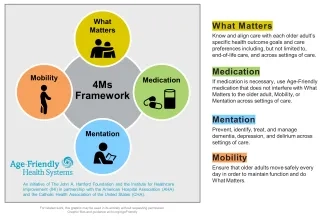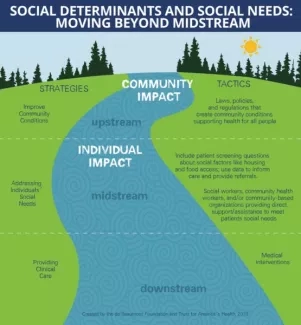Aligner les secteurs de la santé et de la santé publique pour améliorer la coordination des soins adaptés aux personnes âgées
Summary
- Un nouveau document décrit un partenariat intersectoriel entre les secteurs de la santé publique et des soins de santé
Ce qui compte pour les patients est au cœur de l’initiative Age-Friendly Health Systems (AFHS) de l’ Institute for Healthcare Improvement (IHI ). Cela peut signifier donner la priorité à l’expérience des personnes âgées lorsqu’elles rencontrent des problèmes avec les services censés les aider.
Par exemple, dans le cadre de nos efforts visant à valider les documents destinés à aligner l’AFHS sur les efforts de santé publique, nous avons été témoins d’un échange entre une personne âgée et un travailleur de la santé de première ligne. La personne âgée a fait part de sa frustration face à la difficulté de s’y retrouver dans les services de traduction virtuels par téléphone. En revanche, le travailleur de la santé a qualifié le service d’atout majeur pour les communautés où les prestataires ne parlent pas la même langue que leurs patients. À en juger par son langage corporel et ses réactions, la personne âgée ne partageait clairement pas cette évaluation positive.
Lors du compte rendu de la séance de rétroaction, nous avons constaté des appréciations contradictoires. Nous avons finalement décidé d’accorder plus d’importance à l’expérience vécue par la personne âgée et de mettre en avant ses suggestions d’amélioration.
Intégrer les soins adaptés aux personnes âgées dans la santé publique
Comprendre et adapter les soins aux objectifs et préférences de santé de chaque personne âgée (ce qui compte) est un élément essentiel de la prestation de soins adaptés aux personnes âgées. Age-Friendly Health Systems est une initiative de la Fondation John A. Hartford et de IHI, en partenariat avec l'American Hospital Association et la Catholic Health Association des États-Unis. Devenir un système de santé adapté aux personnes âgées implique de fournir de manière fiable un ensemble de quatre éléments de soins de haute qualité fondés sur des données probantes, connus sous le nom de « 4M », à toutes les personnes âgées de votre système : ce qui compte, les médicaments, la mentalité et la mobilité.

Figure 1. Cadre 4Ms d'un système de santé adapté aux personnes âgées
La pandémie de COVID-19 a mis en évidence la nécessité de collaborer avec d’autres acteurs pour intégrer l’approche adaptée aux personnes âgées dans les efforts de santé publique. Depuis 2021, IHI s’associe à Trust for America’s Health (TFAH) et à la Michigan Health and Hospital Association (MHA) pour aligner les Age-Friendly Health Systems sur les systèmes de santé publique adaptés aux personnes âgées. Ensemble, nous avons élaboré le cadre des trois clés pour des soins intersectoriels adaptés aux personnes âgées, qui comprend un guide de mise en œuvre, un cahier d’exercices, un diagramme des facteurs déterminants (comprenant des mesures et des idées de changement) et des cartes du parcours de soins. Un article publié récemment dans Social Innovations Journal , co-écrit par la directrice de projet de IHI, Laura Howell Nelson, décrit cette collaboration intersectorielle et ses résultats.
Le Les trois clés sont :
- Ce qui compte
- Structures de soutien du système
- Structures financières et paysage politique
S’appuyant sur le cadre des approches en amont et en aval utilisées en santé publique, chaque clé fonctionne à différents niveaux afin que les disparités en matière de santé puissent être abordées grâce à une approche systémique. Cela signifie que les soins médicaux sont fournis aux individus tout en plaidant simultanément pour une politique et une réglementation équitables. Nous avons élaboré les trois clés à travers une revue de la littérature, une analyse de l’environnement et, surtout, en faisant appel à des personnes ayant une expérience vécue, par le biais d’entretiens avec des informateurs clés tels que des personnes âgées, des soignants et des dirigeants d’organisations.

Figure 2. Source : « Health Affairs : La satisfaction des besoins sociaux individuels ne suffit pas à répondre aux déterminants sociaux de la santé »
Pour améliorer la santé des personnes âgées du Michigan, l’équipe du projet a mené des entretiens vidéo avec des dirigeants d’organisations afin de comprendre et d’identifier les lacunes en matière de ressources, de soins et de systèmes. À la suite de ces entretiens, il est apparu clairement que nous devions parler aux personnes âgées et aux soignants de leurs expériences.
Le fait de mettre l’expérience des personnes âgées au cœur de nos préoccupations et de les écouter directement a été essentiel au succès de cette initiative. La MHA a dirigé l’effort de sensibilisation, en s’appuyant sur les conseils consultatifs familiaux (FAC) et les organisations parties prenantes, notamment un réseau de centres pour personnes âgées, pour faire passer le message et atteindre un groupe diversifié de personnes âgées et de soignants.
Au printemps 2022, l’équipe du projet a mené des entretiens qualitatifs semi-structurés auprès de 13 adultes de plus de 60 ans ou de leurs soignants afin de comprendre et d’identifier les lacunes et les défis en matière de soins pour les personnes âgées sur une période de trois mois. Pour obtenir une variation maximale des perspectives et des expériences, nous avons recruté des résidents blancs et BIPOC (noirs, autochtones et personnes de couleur) de cinq villes du Michigan. Nous avons obtenu un échantillon de participants diversifié, les participants déclarant des identités de genre et des statuts socioéconomiques divers et 38 % de l’échantillon s’identifiant comme BIPOC. La majorité (53 %) s’est identifiée comme blanche. Les entretiens ont inclus des participants des communautés rurales (53 %) et urbaines (38 %).
Pour les deux séries d’entretiens, nous avons mené des analyses qualitatives pour comprendre l’impact du système actuel et les points positifs existants. Nous avons également demandé aux personnes les plus touchées ou les plus proches des systèmes de formuler des recommandations sur la manière d’améliorer le système. Les thèmes, en particulier ceux issus des entretiens avec les personnes âgées et les aidants, nous ont aidés à générer les trois clés et ont été des éléments clés du diagramme du conducteur et des cartes du parcours de soins.

Figure 3. Diagramme des trois facteurs clés des soins intersectoriels adaptés aux personnes âgées
Après avoir rédigé le diagramme des facteurs déterminants et les cartes du parcours de soins, l’équipe de projet a invité les dirigeants d’organisations, les personnes âgées et les soignants à examiner les documents générés à partir de leurs entretiens lors de « séances de validation ». Nous avons organisé deux séances au début de 2023 pour intégrer leurs commentaires et nous assurer que nous avons centré les personnes âgées dans tous les documents. En d’autres termes, notre objectif était de vérifier que nous avons pleinement représenté les expériences des participants dans le cœur du cadre et dans les documents d’appui, plutôt que de les présenter comme un élément secondaire ou une réflexion ultérieure. Sans y être invitée par les animateurs, une dirigeante d’organisation a déclaré qu’elle pouvait voir ce qui compte pour les personnes âgées dans tout le cadre et les documents d’appui.
Laura Howell Nelson est directrice de projet à IHI .
Vous pourriez également être intéressé par :
Le 10 avril 2024, les Centers for Medicare & Medicaid Services (CMS) ont proposé la mesure Age-Friendly Hospital . Elle encourage les hôpitaux à améliorer les soins pour les patients âgés de 65 ans ou plus. Vous pouvez montrer votre soutien à cette mesure importante visant à améliorer la qualité des soins pour les personnes âgées en laissant un commentaire avant le lundi 10 juin 2024. Pour plus de détails : Age-Friendly Attestation Measure in the Federal Register .
Social Innovation Journal — « Engager les principales parties prenantes dans l’élaboration d’un cadre et d’une boîte à outils pour une coordination intersectorielle des soins adaptés aux personnes âgées : trois clés pour aligner les secteurs des soins de santé et de la santé publique. »
Trois clés pour des soins intersectoriels adaptés aux personnes âgées — comprend l'ensemble complet des cartes de parcours de soins et le diagramme des facteurs déterminants
